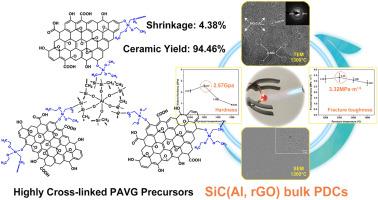Journal of Alloys and Compounds ( IF 5.8 ) Pub Date : 2021-02-23 , DOI: 10.1016/j.jallcom.2021.159297 Lingjie Li , Zhonghao Ning , Wenyan Huang , Liang Liao , Yinong Zheng , Kun Zhuang , Siqi Lan , Yinggan Zhang , Rongqian Yao

|
An ingenious strategy to prepare in-situ formed SiC(Al, rGO) bulk polymer-derived ceramics (PDCs) from re-pyrolyzing SiC(Al, rGO)p/polyaluminocarbosilane-vinyltriethoxysilane-graphene oxide (PACS-VTES-GO, PAVG) blends is highlighted. Flexible PAVG modified by Al with highly cross-linked structure effectively improves molecular weight and formability of precursors. Rigid SiC(Al, rGO)p fillers provide high mechanical properties owing to their unique microstructure which is consistent with SiC(Al, rGO) bulk PDCs. β-SiC nanocrystals are well dispersed in amorphous SiOxCy/Cfree, and rGO exhibits good compatibility with SiOxCy/Cfree. Besides, possible Al2O3 is beneficial to relaxing thermal stress at β-SiC nanocrystalline boundaries. Interestingly, introduction of Al could avoid coarsening of β-SiC grains to enhance elevated temperature resistance. Furthermore, effect of re-pyrolysis temperature on the formation and microstructure of SiC(Al, rGO) bulk PDCs was also investigated. Particularly, lightweight samples re-pyrolyzed at 1300 °C display optimal fracture toughness (3.32 MPa m1/2), compressive strength (177.16 MPa) and flexural strength (51.25 MPa), high ceramic yield (94.46%) and low linear shrinkage (4.38%), by far superior to those of most PDCs. As treated via precursor infiltration and pyrolysis (PIP) route and heated by butane gun flame in air, such products possess stable structures under elevated temperatures and have potential emerging uses in aerospace components.
中文翻译:

从碳氧化硅衍生的轻质SiC(Al,rGO)块状陶瓷的原位制造用于航空航天组件
通过重新热解SiC(Al,rGO)p /聚铝碳硅烷-乙烯基三乙氧基硅烷-氧化石墨烯(PACS-VTES-GO,PAVG)来制备原位形成的SiC(Al,rGO)本体聚合物衍生陶瓷(PDC)的巧妙策略混合突出显示。由Al改性的具有高交联结构的柔性PAVG可有效提高前驱体的分子量和可成型性。刚性SiC(Al,rGO)p填料由于其独特的微观结构与SiC(Al,rGO)块状PDC一致而具有很高的机械性能。的β-SiC纳米晶体良好地分散在非晶质的SiO X Ç ý / C自由,并RGO表现出与二氧化硅良好的相容性X Ç ý / C免费。此外,可能的Al 2 O 3有助于缓解β-SiC纳米晶边界处的热应力。有趣的是,引入Al可以避免β-SiC晶粒粗大化,从而提高耐高温性。此外,还研究了再热解温度对SiC(Al,rGO)块状PDC的形成和微观结构的影响。特别是,在1300°C下重新热解的轻质样品显示出最佳的断裂韧性(3.32 MPa m 1/2),抗压强度(177.16 MPa)和抗弯强度(51.25 MPa),高陶瓷屈服(94.46%)和低线性收缩率(4.38%),远远优于大多数PDC。通过前驱物渗透和热解(PIP)路线进行处理,并通过丁烷枪火焰在空气中加热,此类产品在高温下具有稳定的结构,并在航空航天组件中具有潜在的新兴用途。











































 京公网安备 11010802027423号
京公网安备 11010802027423号